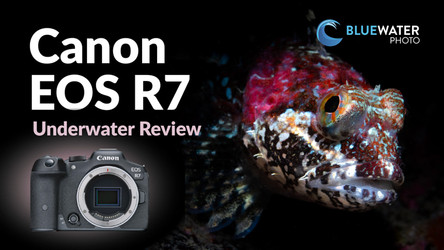Canon R7 Underwater Review
Posted by Nirupam Nigam on January 30th, 2023

The Canon EOS R7 is Canon's newest and highest performing APS-C mirrorless camera. It is an excellent option for those looking for an incredible value in an underwater camera - both for photo and video. At $1499 for the camera body, the R7 is capable of capturing 32 MP photos with 5-axis in-body image stabilization and 4K/60p video. It is also equipped with a top of the line dual-pixel autofocus system brought over from the popular Canon EOS R5 - capable of tracking animal eyes.
The R7 was announced alongside the Canon EOS R10, its "little brother" with less features, but an even lower price point of $980 for the camera body. Though the two cameras are similar, they represent slightly different tools for different markets. In this underwater review of the Canon EOS R7, we will cover the differences between the two cameras and whether or not it's worth the upgrade to the R7.
A Note on Dive Conditions
Over the past month, we had the opportunity to dive with the Ikelite Canon R7 underwater housing in the cold, 45F waters of the Pacific Northwest. As some of you may have seen, this winter has been brutal for dive conditions across the West Coast. With dense rainfall, high winds, and high surge, it was difficult for us to dive with conditions that were good enough to capture underwater photos and video. Please keep this in mind when you compare images from our R7 and R10 underwater reviews. Other tools we used in this review include the Ikelite DS 230 strobes, the Ikelite Canon TTL converter, the Marelux SOFT Pro snoot, and the SeaLife SeaDragon 5000+ video light.
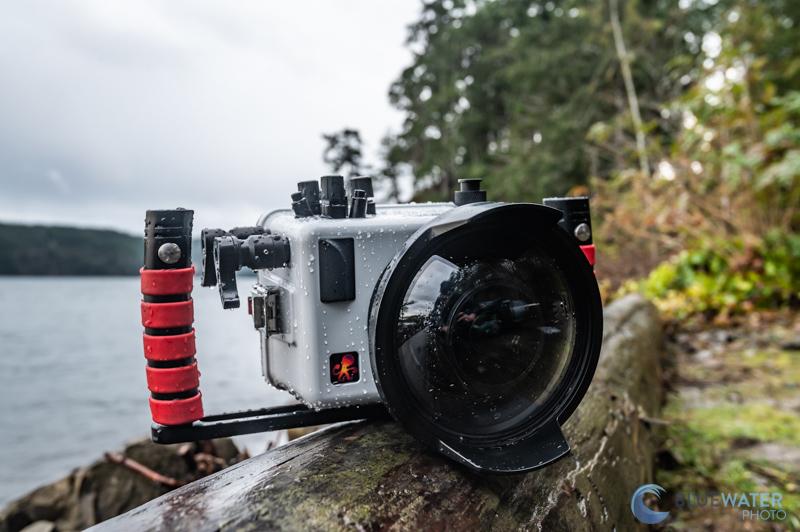
The Canon R7 After a Rainy Day in the Field
Jump to a Section
Canon EOS R7 Specifications | Canon R7 vs R10 | Key Features
Canon EOS R7 for Underwater Photo & Video |
Top Underwater Lenses | Top Underwater Housings
Conclusions
Check out the best underwater settings for the Canon EOS R7
Canon EOS R7 Specifications
- 32.5 Megapixel APS-C CMOS Sensor
- DIGIC X Image Processor
- 5-axis in-body image stabilization
- Canon RF lens mount, can support EF lenses via the Canon EF-EOS adapter
- Dual Pixel AF II with improved animal, vehicle, people AF tracking (both photo & video mode)
- AF focuses in lowlight down to -5 EV
- AF points cover 100% of the sensor
- 2.36 million dot EVF (electronic viewfinder)
- 1/250 max sync speed with strobes
- 15 fps burst shooting with the mechanical shutter and 30 fps burst shooting with the electronic shutter
- 4K/60p video with no crop, 10-bit 4:2:2 recording
- C-Log3 recording supported
- LP-E6NH battery
- Size dimensions: 132.0 x 90.4 x 91.7mm
- Weight: 1.3 lbs (590 grams)
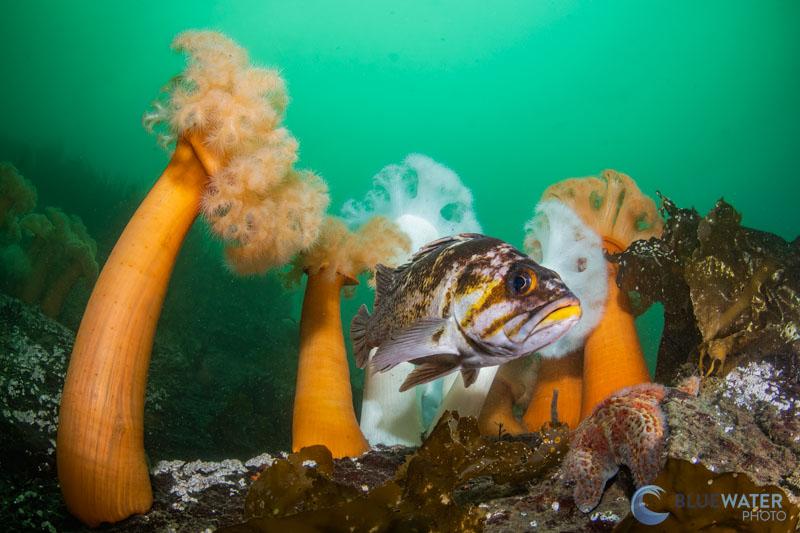
Excellent dynamic range and detail captured with the Canon EOS R7 in an Ikelite R7 housing with a Tokina 10-17mm fisheye lens and dual Ikelite DS 230 strobes. f/9, 1/80, ISO 500
Canon EOS R7 vs R10....Which One Should I Buy?
With a $500 difference between the R7 and the R10, we have a lot of customers wondering if the R7 is worth the "upgrade." There are a lot of factors that can go into this decision so lets start with performance.... The Canon R7 has a slightly higher resolution sensor than the R10 at 32.5 MP vs 24.2 MP on the R10. If you are a macro shooter that likes to crop in post, this upgrade in resolution can certainly be worth the upgrade. For wide angle shooters it might not be unless you plan on producing large prints. We were initially worried this increase in resolution would produce more noise at higher ISOs in the R7, but we could not discern any noticeable difference between the R7 and R10.
The R7 is also equipped with 5-axis in-body image stabilization with up to 7 stops of correction. We found that it works extremely well for both photo and video. This allowed us to shoot at ultra low shutter speeds like 1/15th of a second without motion blur from camera shake - and essential feature when shooting on dark, rainy days with limited visibility. In our underwater video, our clips were noticeably more stable when shooting handheld video than with the R10.
It's also important to note that the R7 has a slightly higher max sync speed with strobes - at 1/250 of a second, vs 1/200 of a second on the R10. This isn't a huge difference, but it does make the R7 a slightly better tool for sunball photography and action photography.
If you are an underwater video shooter, the R7 is the clear choice over the R10. We recommend filming at 4K/60 fps while filming underwater in order to stabilize it in post production. The R7 offers 4K/60p recording without a crop, whereas the R10 has a 64% crop when filming 4K/60p. Moreover, the R7 offers C-Log3 recording for those that don't mind doing a little bit of color grading in post production in order to get more dynamic range in their video. These two features alone, make the R7 our recommendation for video shooters (though the R10 does an excellent job as well).
Finally, it's important to consider underwater housing options when comparing the two cameras. Despite the R7 being heavier and larger, both Ikelite and Nauticam managed to fit it into their smaller, APS-C style housings. The R10 currently only has an Ikelite housing option available. This housing is sold as a package - making the R10 the best value underwater camera system on the market. If you are looking for an anodized aluminum housing option, then the Nauticam R7 housing is the only option available as there are no aluminum R10 housings available. We recommend pairing this housing with the Canon RF-S 18-45mm kit lens and the Nauticam WWL-1B. The Ikelite R7 housing option is made from polycarbonate - which we recommend pairing with the Tokina 10-17mm fisheye lens and the Canon RF100 mm macro.
So who should buy the R10 and who should by the R7? If you are looking for a great underwater camera at a great price - you'll be happy with the R10. If you are looking for a top of the line system in a small package, the R7 would be the best choice. Finally, if you are a macro or video shooter, you may want to consider the R7 over the R10.
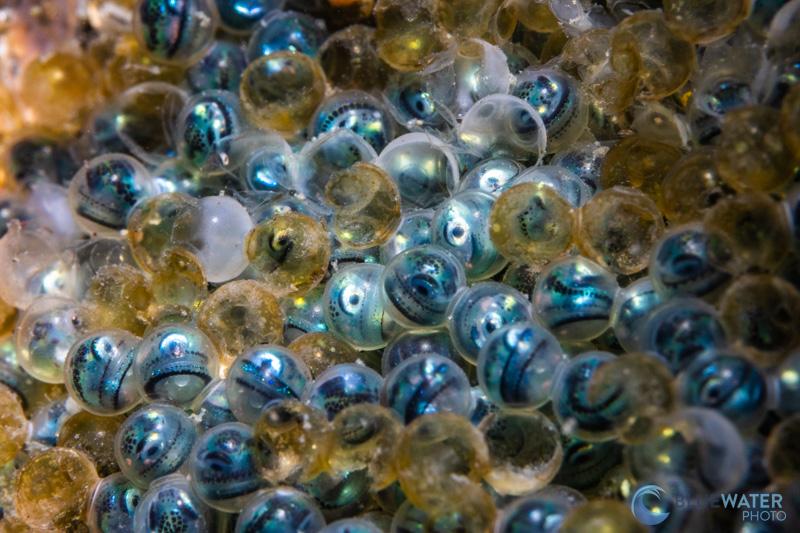
With more resolution on the Canon R7, macro shooters can crop more into their images without losing details. This image of greenling eggs was captured with the Canon EOS R7 in an Ikelite R7 housing with a Canon RF 100mm macro lens and a Marelux Soft pro snoot. f/16, 1/160, ISO 320
Canon R7 Key Features
Compact and Ergonomic Body Design
The most obvious benefit of shooting a cropped sensor, APS-C camera is the smaller body size. At 1.3 lbs, the Canon R7 is a lightweight camera, but it's still larger and 100 grams heavier than the Canon R10. This is due to the image stabilization system that results in a deeper body. For topside shooting, the smaller size of the R10 can be a nice benefit over the R7, but underwater the housing sizes are the same.
The Canon R7 clearly has a sturdier design and is made of higher quality material than the light plastic that forms the R10 body. The button layout is very well placed for both topside and underwater shooting - including a new dial/joystick hybrid control. The R7's layout is reminiscent of the Canon R5 and should be familiar to Canon photographers. Shutter speed and aperture is controlled by easy to reach dials, whereas ISO is controlled via a button.
Overall, the R7 represents an extremely travel friendly set up for underwater photographers. I was able to cut out 7 lbs from my travel bag when lenses, housing, and ports were all taken into account.
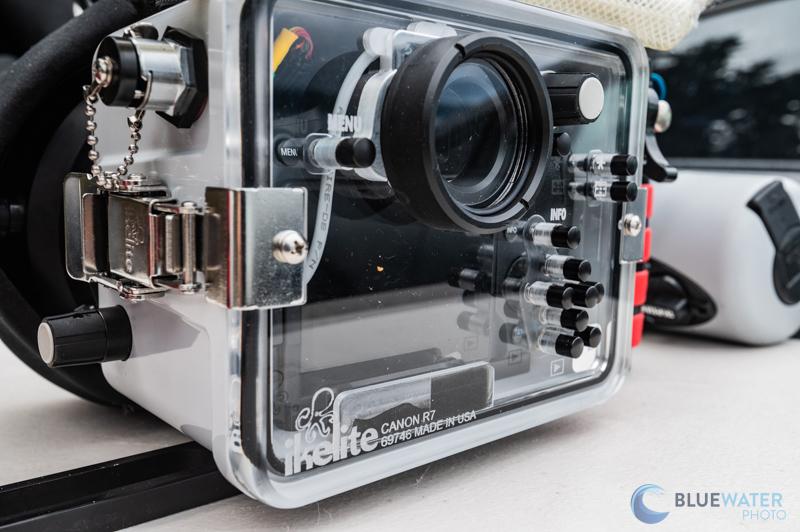
The button layout on the Canon EOS R7 underwater housing
5-Axis In-Body Image Stabilization
One of the crowning features of the Canon EOS R7 is 5-axis in-body image stabilization (IBIS). IBIS works by building a structure around the sensor that allows the sensor to move in conjunction with little movements of the camera body. This reduces motion blur from camera shake and allows you to shoot at shutter speeds up to 7 stops slower than you normally could.
We found the IBIS in the R7 to be almost as effective as the IBIS system on the Canon R5 - one of the world's best. It makes handheld underwater video shooting, especially macro video, much more stable and effective. We were also able to shoot underwater photos down to 1/15th of a second shutter speed without camera shake. This was very useful in the extremely dark underwater conditions we were dealing with - and I was able to get nice green backgrounds that would have been black if my shutter speed was higher.
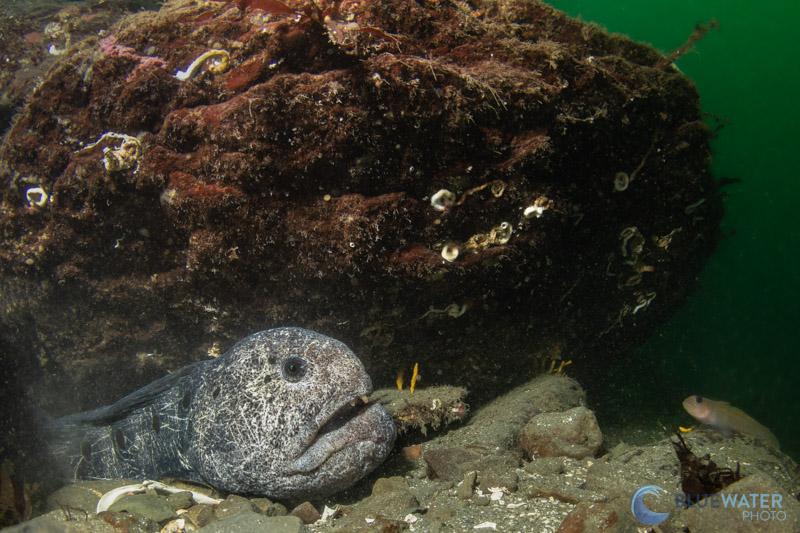
The In-Body Image Stabilization built into the Canon EOS R7 allows photographers to shoot at slow shutter speeds in order to get nicer colors in backgrounds on dark days. This wolfeel was photographed at a slow shutter speed with the Canon R7 in an Ikelite R7 housing, dual Ikelite DS 230 strobes, and Tokina 10-17mm fisheye lens. The subject is crisp and the background is green instead of black. f/9, 1/30 second shutter speed, ISO 500
Top-of-the-Line APS-C Image Quality
The Canon EOS R7 has a high resolution 32.5 megapixel APS-C CMOS sensor. It is the perfect choice for underwater macro shooters that would like to take advantage of the 1.5x crop factor of an APS-C sensor and combine it with a high megapixel count for additional cropping in post processing. While we thought the additional resolution would have an effect on the sensor in low light, we found that there was no additional noise compared to the R10. The sensor performed quite well in low light and had comparable dynamic range to the Canon EOS R10.
Overall we've been super impressed with the details in our Canon R7 photos. We would have loved to do some sunball shots to compare them to the R10, but unfortunately conditions did not cooperate. One thing is for sure - at higher ISOs on dark days, the camera preforms excellently. Any noise that was in our images was easy to remove in post without a significant degradation in quality. We could comfortable shoot the Canon R7 up to ISO 800.
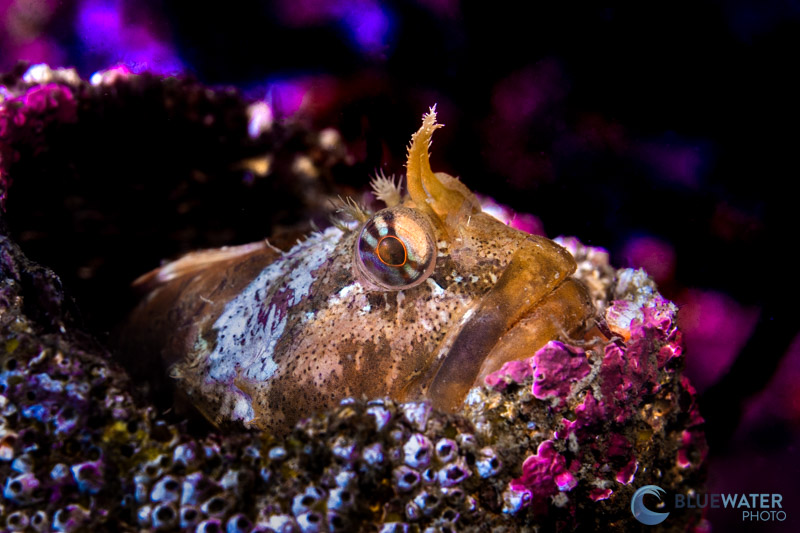
32.5 megapixels is ideal for macro photographers who want to crop in Lightroom. This photo of a male scalyhead sculpin was photographed with the Canon EOS R7, the Canon 100mm RF macro lens, and the Marelux SOFT color filters. f/6.3, 1/100, ISO 320
Professional Autofocus
The dual pixel autofocus system on the R7 is reason enough to purchase the camera. 100% of the camera sensor is covered with autofocus points, giving it a significant composition advantage over DSLR cameras of yesteryear. What's most exciting about the camera is that Canon did not hold back when moving the autofocus system from the full frame R3 and R5 into the camera. The R7 is equipped with animal eye autofocus tracking that works decently well with fish eyes. In fact, when we took photos with the R7, it was the first time we were able to reliably track fish eyes with a wide angle lens. Typically the eye tracking works better with macro lenses. Moreover, Canon redesigned the camera to include autofocus tracking in each of the area modes built into the autofocus servo method. This gives the user a lot more options when it comes to the area that you wish to track.
During our dives, we kept the camera almost exclusively in the autofocus servo mode with single point autofocus tracking. This allowed us to lock onto our subject via the AF-on lever on the housing and the autofocus box would follow it around whether the camera was moving or the subject itself.
It was also clear that the Canon EOS R7 was better at autofocusing in lowlight than the R10 and it did an excellent job of focusing without a focus light.
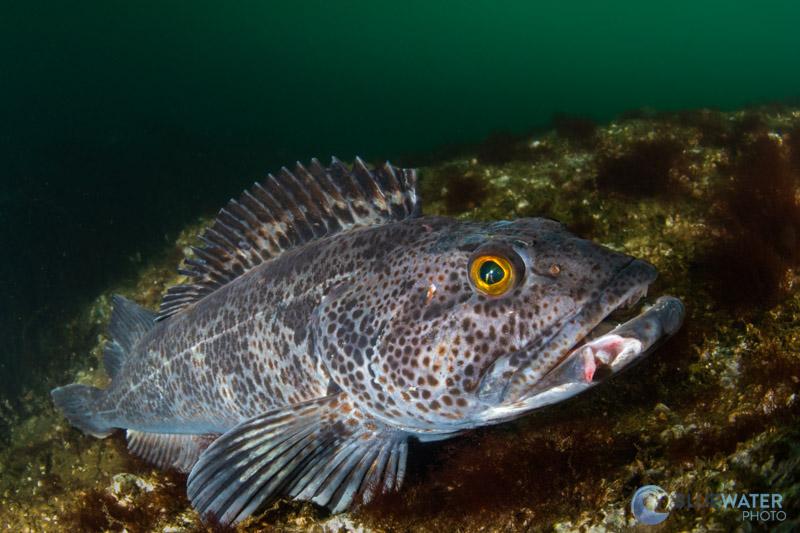
Animal eye autofocus tracking was successful in this wide angle photograph of a lingcod. Photo captured with the Canon R7 in an Ikelite R7 housing, dual Ikelite DS 230 strobes, and the Tokina 10-17mm fisheye lens. f/9, 1/80, ISO 500
Battery Life
The battery life on the Canon EOS R7 is plain incredible. Like the Canon EOS R10, we were able to shoot with the R7 over two days of diving and still have 30% of the battery left over. While its rated for 600 shots on a full charge, we think it could reasonably last 6 to 8 dives. As long as you charge the battery after each day of diving, you should never have to worry about battery life on the R7.
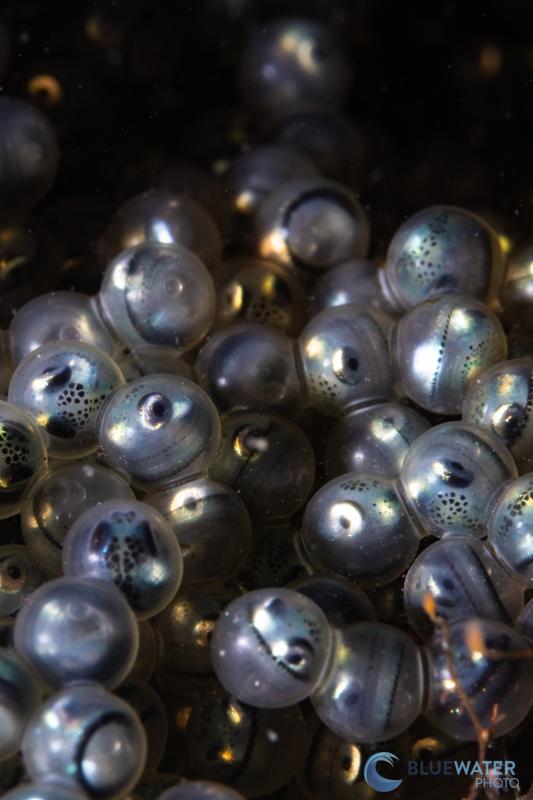
Another macro perspective on greenling eggs. f/16, 1/160, ISO 320
Cutting Edge Video Capability
The Canon R10 is the best APS-C camera on the market for underwater video. It is capable of filming 4K video at 60 fps using the full width of the sensor. This means that there is no crop when filming in 4K/60p. We recommend filming in 4K/60p underwater as it allows you to slow down your video footage in post processing for better stabilization. Combined with the IBIS system, the R7 is one of the easiest cameras to film hand-held video footage underwater.
Beyond that, the Canon R7 can film C-Log3 logarithmic footage, unlike the Canon R10. This allows video shooters to get more details out of their footage by color grading in post processing.
Custom white balances are easy to set in photo mode, but unfortunately do require taking a photo and going into the menu in video mode. That said we found the colors from the Canon R7 to be extremely accurate at depth. The R7's "color science" is much more effective overall than anything we've seen in the Sony APS-C line of cameras.
Canon EOS R7 for Underwater Photography
Overall, we think the Canon R7 just might be the best APS-C camera for underwater photography on the market. Compared to any other leading APS-C camera like the Sony A6400, the Nikon Z50, or the Canon R10, the R7 has better autofocus, better image quality, and better video capabilities.
The high resolution sensor is perfect for macro shooters that also want to take advantage of the 1.5x relative crop of the APS-C sensor. It's also a great camera for coldwater divers that need to shoot at higher ISOs and focus in dark conditions.
We were extremely impressed with the autofocus tracking. The whole shooting experience feels like shooting a mini Canon R5. And that's the key - "mini". The R7 is truly a "mini" professional camera. It's one of the most travel friendly packages of an high performance camera on the market - an essential quality for anyone who travels to dive.

A nudibranch photographed with the Canon EOS R7 camera in an Ikelite R7 housing, the Canon 85mm macro lens, and the Marelux SOFT pro. f/16, ISO 400, 1/125
Canon EOS R7 for Underwater Video
The Canon R7 is also the best APS-C camera on the market for underwater video. Moreover, the quality of the video from the R7 stands up and surpasses the Panasonic GH6. While the R7 does have all of the features of this video oriented camera - with better lenses and a better sensor - it produces better video quality over all than the GH6.
With logarithmic shooting available at 10-bit 4:2:2 4K/60p - it's a clear choice over the R10 for video. We felt the footage benefited nicely from the built in IBIS system and custom white balances yielded excellent colors at depth.
Top Canon R7 Underwater Lenses
The Canon R7 is one of the first Canon APS-C cameras to feature the RF mirrorless lens mount. However, it also supports EF lenses with a Canon EF-EOS R adapter. Autofocus when using the adapter is just as seamless as shooting an EF lens without an adapter.
Wide Angle Lens Options
Our favorite wide angle lens for the Canon EOS R10 is the classic Tokina 10-17mm fisheye lens. This lens is tried and true among underwater photographers and allows you to get close to large subjects for better color and detail. You will need the EF-EOS R adapter to use the Tokina 10-17mm.
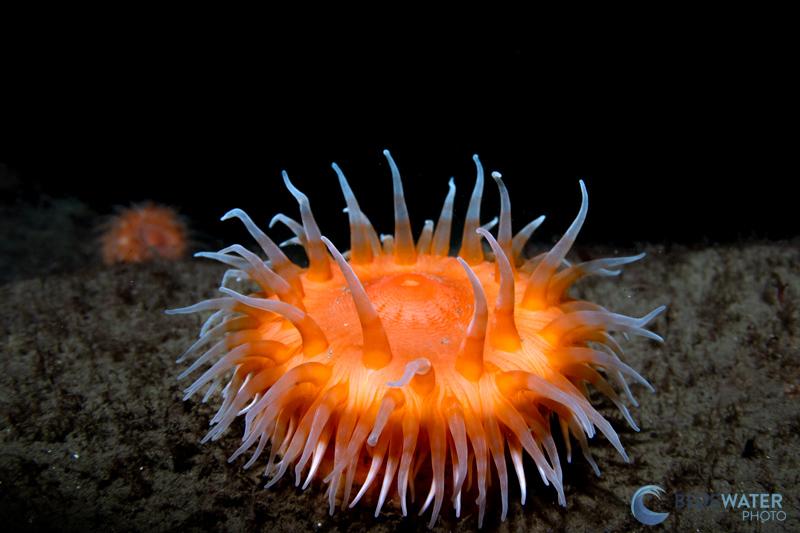
An anemone photographed with the Canon EOS R7 and the Tokina 10-17mm fisheye lens
Mid-Range Kit Lens Option
The Canon RF-S 18-45mm f/4.5-6.3 IS STM kit lens is a good lens for both topside and underwater shooting. It is compact and a great all around lens for mid range photography and portraits. We think this is a nice starter lens, but you will get better results with a dedicated wide angle or macro lens. The best combination with the kit lens for underwater photography is to shoot it in the Nauticam R7 housing with a Nautiam WWL-C or WWL-1.
Macro Lens Options
There are three great macro lens options for the Canon EOS R7. The Canon EF-S 60mm f/2.8 macro lens is an excellent option when combined with the Canon EF-EOS R adapter. However, this lens is discontinued so you will have to buy it used if you do not already have it.
The Canon EF 100mm f/2.8 macro lens is another great option with the EF-EOS R adapter. We actually enjoyed using this lens better than the 60mm macro because it gave us more working distance with our subjects.
Finally the Canon RF 100mm f/2.8 macro lens is also compatible with the R10, and is considered by many to be the world's best macro lens. This was our favorite lens to shoot with the Canon R7. We were initially worried that it could be a bit too "telephoto" combining a 100mm lens with an APS-C sensor. However, the autofocus speed is so quick, it negates the difficulty in shooting a long macro lens on an APS-C sensor.
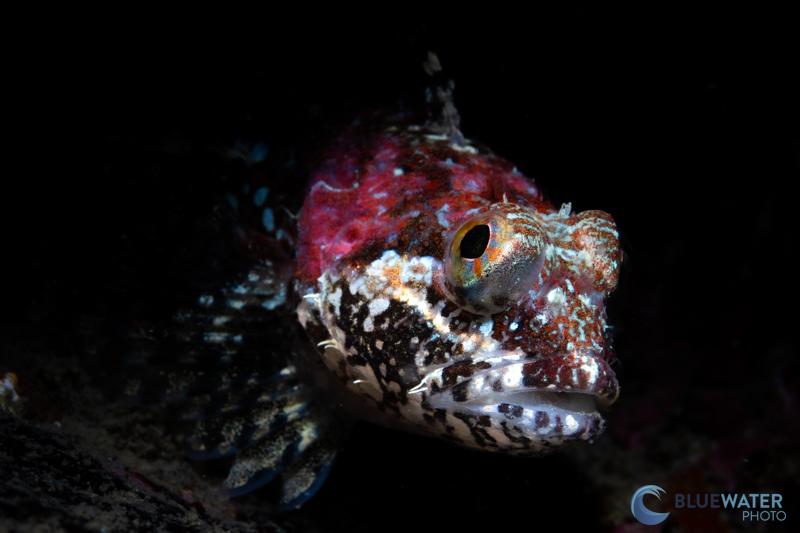
A scalyhead sculpin photographed with the Canon EOS R7 and Canon RF 100mm macro lens.
Canon R7 Underwater Housings
There are currently two great underwater housing options available for the Canon EOS R7 - the polycarbonate Ikelite R7 housing and the anodized aluminum Nauticam R7 housing.
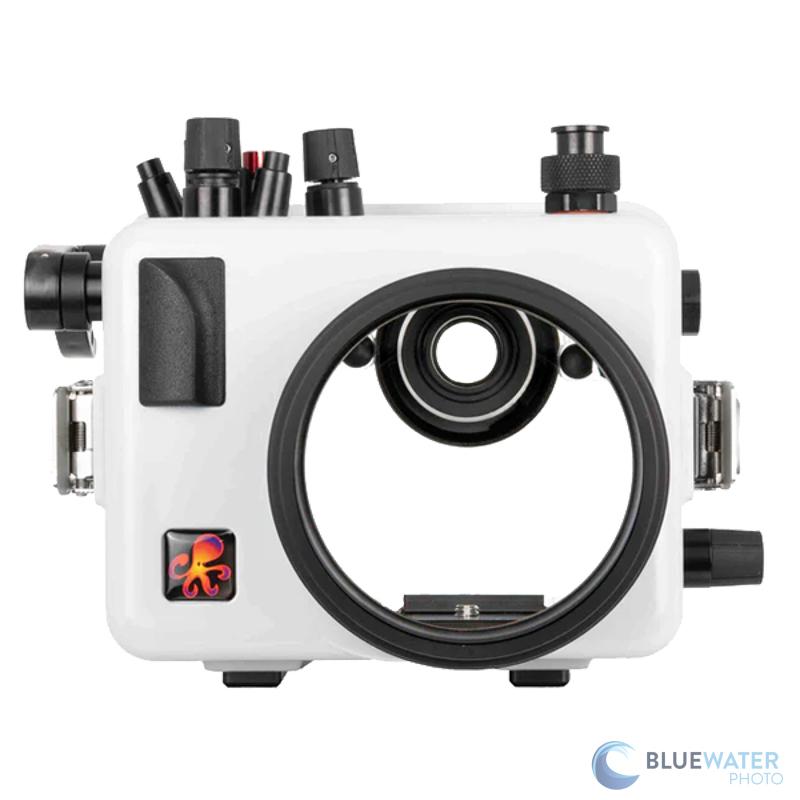
The Ikelite EOS R7 underwater housing is an excellent value at only $1,195 for the housing. It offers full functionality of the Canon R7, and we found that the camera fit very tightly into the housing - leaving no extra air space and making the housing as small as possible. The housing is built with a shutter lever and AF-on lever that make it really easy to lock your focus and take photos. The dials on the housing offer full control of shutter speed and aperture and it's very easy to access all important settings through the Q menu. This housing is compatible with the Ikelite Canon TTL converter that works with Ikelite strobes. We found that our exposures were extremely accurate with TTL.
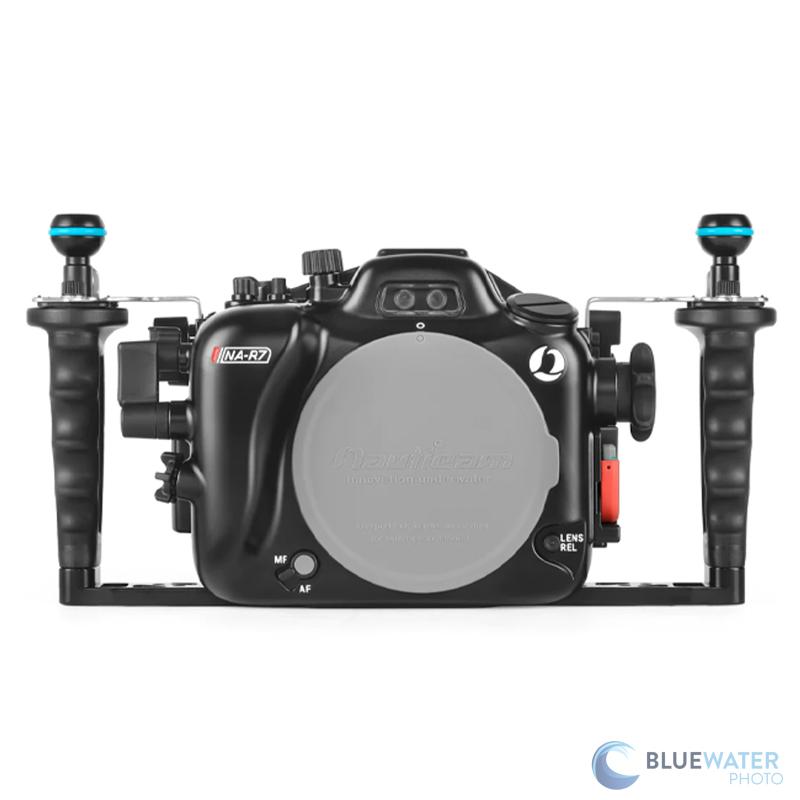
The Nauticam Canon EOS R7 underwater housing is an excellent anodized aluminum housing that retails for $3163. We recommend using the Canon 18-45mm kit lens with this housing as it pairs nicely with the Nauticam WWL-1 for wide angle shooting and the Nauticam CMC-2 for macro shooting. This system can be used with the bayonet mounts that can be mounted onto your arms.

To fully maximize the potential of your camera and at the same time have a great time shooting, packages are available. But if you prefer a fully customized underwater rig for your shooting style, contact sales@bluewaterphotostore.com
Conclusions
If you are looking for the best APS-C camera for underwater photography that money can buy - the Canon R7 is it. That's not to say you need a lot of money (relatively speaking). The Canon R7 performs much like a high end full frame camera at less than half the price. We were very impressed with it's performance in some rough dive conditions that would have pushed any camera to it's limits. At the end of the day, our photos at ISO 640 were nice and clean, our photos at 1/15 of a second were nice and crisp, and our video at 4k/60p was beautiful to watch with no crop.
We expect that this camera will be a popular with photographers that need high-end professional quality and performance for an affordable price point. While the Canon R10 provides a slightly better value, it's only $500 more to get all the bells and whistles in the R7.
Finally, it's important to take a step back and say - the world of photography and video is changing. With the burden of autofocus and stabilization shifting to increasingly better performing cameras, it's nice to see that creatives can focus on composition rather than making sure their camera does what it needs to do. If you can get all of that for an entry level price point, the you really don't need much more.
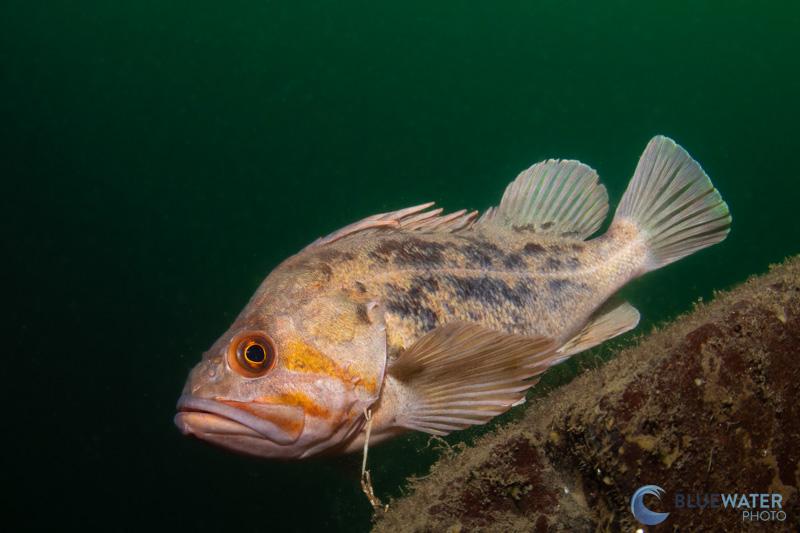
Strikingly realistic image quality from the Canon EOS R7. /8, 1/180, ISO 500

